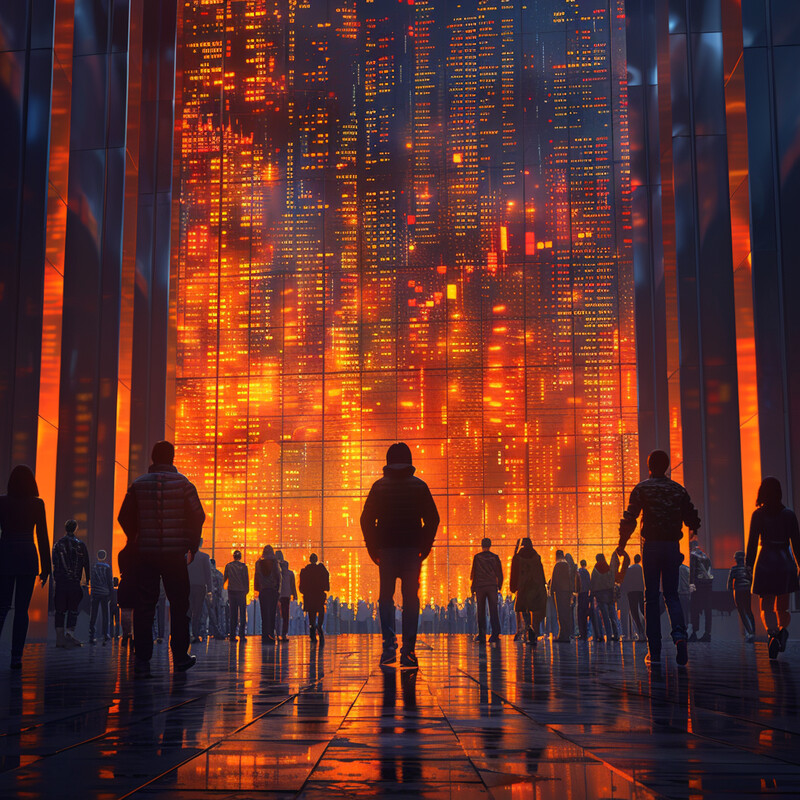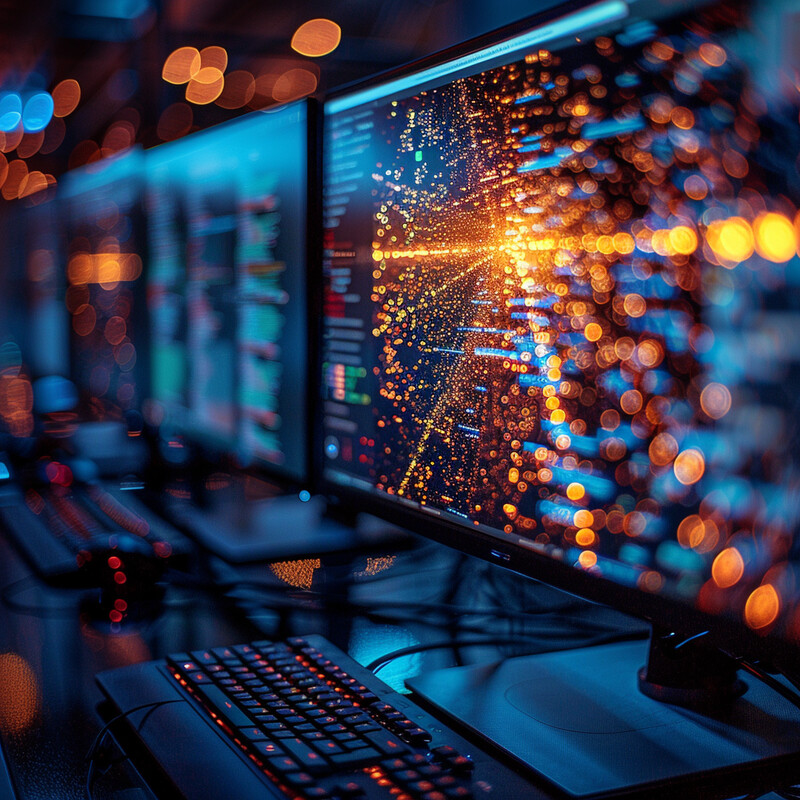1. Audience Segmentation
AI-driven audience segmentation involves analyzing massive datasets of consumer behavior to identify distinct groups of customers with common characteristics. Machine learning algorithms can uncover granular segments based on browsing patterns, purchase history, demographics, and preferences – often far more precisely than traditional manual methods. By continuously updating these segments as new data arrives, AI ensures marketers can target each group with highly relevant ads and messaging. This leads to more efficient ad spend and higher engagement, since campaigns can be tailored to the specific interests and needs of each audience segment. In short, AI enables a data-driven approach to grouping consumers, allowing advertisers to focus on the most receptive audiences and improve overall campaign performance.

Over half of marketers (around 55%) reported using AI to improve audience segmentation and targeting as of 2023
2. Predictive Analytics
In advertising, AI-powered predictive analytics uses historical consumer data and machine learning to forecast future behavior and trends. By examining patterns in past interactions (such as clicks, conversions, and purchase cycles), AI models can predict outcomes like which users are most likely to convert or when demand for a product will spike. Advertisers leverage these predictions to anticipate customer needs and proactively tailor campaigns – for example, targeting users predicted to be interested in a product or adjusting budgets before a trend peaks. This capability helps optimize marketing strategies in advance, rather than just reacting to past performance. Overall, AI’s role in predictive analytics is to enable evidence-based decision-making about where to allocate advertising resources for maximum future impact.

According to a 2023 industry survey, 53% of marketing leaders are already using or planning to use AI for predictive analytics and customer insights in order to guide their campaigns.
3. Personalized Ad Content
AI enables highly personalized ad content by learning individual user preferences and dynamically tailoring creatives to each person. Using data such as a user’s browsing history, past purchases, location, and even contextual clues, AI systems can generate or select ads most relevant to that specific user. For example, an e-commerce platform’s AI might show a user products in their favorite style or category, or adjust an ad’s imagery and language to resonate with that user’s profile. This level of one-to-one personalization was impractical at scale before AI; now algorithms can automate the customization for millions of users in real time. The result is that consumers see ads that feel more personally relevant, which studies show increases engagement and conversion rates. By tailoring messages to individual interests, AI-driven personalization makes advertising more effective and improves the user experience.

Gartner analysts projected that by 2024–2025 roughly 75% of midsize and large organizations will be using AI-powered content generation tools to personalize marketing content, reflecting how mainstream individualized ad targeting has become.
4. Optimal Ad Placement
AI plays a crucial role in determining the optimal placement and timing of ads to maximize their impact. Advanced algorithms analyze user engagement data across platforms and time periods to learn when and where target audiences are most active and receptive. By factoring in variables like time of day, device type, ad format, and user context, AI can automatically schedule ads or choose ad slots that are predicted to yield the highest visibility and click-through rates. It also adjusts bids and budgets in real time to favor high-performing placements (for example, displaying an ad on a specific app during hours when its target demographic is online). This data-driven optimization helps advertisers avoid waste—ensuring ads run in the right places at the right times—and often improves return on investment. In essence, AI optimizes media placement strategies that would be too complex for manual human planning.

Case studies indicate that AI-driven ad targeting and placement can boost advertising performance significantly – for instance, one analysis showed about a 30% increase in ad performance and a 25% reduction in advertising costs when using AI to automate placement decisions.
5. Real-time Bidding
Real-time bidding (RTB) is an area of programmatic advertising where AI algorithms make split-second decisions in digital ad auctions. In RTB, each time a webpage or app is loaded, an auction occurs in milliseconds for the available ad impression; AI analyzes the website context and the user’s profile in that instant and decides how much to bid for the ad placement. The role of AI here is to evaluate vast numbers of impressions and bid optimally, all within fractions of a second. It uses predictive models to estimate the value of showing an ad to a particular user (likelihood of click or conversion) and adjusts bids accordingly to win valuable impressions at the best price. This automation allows advertisers to target users with precision at scale, far faster than any manual bidding system. As a result, AI-driven real-time bidding ensures that ad spend is allocated to the most effective opportunities, improving efficiency and campaign ROI.

Programmatic advertising—which relies on AI-driven real-time bidding—has become the dominant method for buying display ads. By 2025, it is on track to account for about 90% of worldwide digital display ad spending, underscoring how nearly all growth in display advertising is now coming from AI-automated bidding processes.
6. Sentiment Analysis
AI-powered sentiment analysis allows advertisers to gauge public opinion and emotional responses to brands or campaigns by analyzing text data at scale. Tools backed by natural language processing scan social media posts, product reviews, comments, and other online content to determine whether the sentiment expressed is positive, negative, or neutral. In advertising, this insight helps marketers understand how consumers feel about their brand or a specific ad in real time. For example, if an ad campaign is getting negative social media sentiment, AI analytics would flag this trend quickly, enabling the marketing team to adjust messaging or address concerns. Conversely, strong positive sentiment around a new product can be leveraged in promotional materials. By monitoring sentiment, AI helps advertisers remain agile – aligning campaigns with audience mood and reception. It essentially provides a feedback loop where strategies can be tuned according to the evolving voice of the customer.

Research by Gartner in 2023 highlighted the growing importance of sentiment analysis, noting that by the end of 2023 about 72% of customer service and experience leaders had piloted or adopted AI-driven sentiment analysis solutions to better track customer feedback across channels. This reflects how widely companies are investing in sentiment monitoring to inform their strategies.
7. Image Recognition
AI-based image recognition in advertising allows brands to analyze and leverage the vast amount of visual content shared online. Using computer vision techniques, AI can scan images and videos on social media or the web to identify brand logos, products, or even user demographics and contexts. For advertisers, this means they can quantitatively track visual mentions of their brand (for example, a soda company can see how often and where its bottle appears in users’ Instagram photos). These insights help measure brand visibility and sponsorship ROI, and they can inform influencer marketing strategies by identifying popular user-generated content featuring the product. Additionally, image recognition enables ad systems to place contextually relevant ads next to images – for instance, showing an apparel ad when a user’s feed contains images of fashion items. AI’s ability to “see” and interpret images at scale opens up a new layer of data for targeting and campaign optimization that was previously inaccessible to marketers.

Modern AI logo detection tools have become remarkably accurate – most leading image recognition systems can recognize and classify brand logos in images with over 90% accuracy, thanks to advances in deep learning. This high precision enables reliable tracking of brand presence and ensures that insights drawn from visual data (like how often a logo appears) are trustworthy for advertising analytics.
8. Chatbots and Interactive Ads
AI-driven chatbots and interactive ads create a two-way communication channel with consumers, transforming ads from static messages into engaging conversations. In this domain, AI is used to understand user queries and respond in real time with relevant information or recommendations. For example, an interactive ad for a car might let users “chat” to schedule a test drive or ask about features, with an AI chatbot handling the dialogue. This personalized interactivity keeps users engaged longer than a typical one-way ad and can capture valuable data on customer preferences and questions. Chatbot-based ads also serve as always-on sales assistants — they can qualify leads, suggest products, or even complete transactions within the chat interface. By providing instant responses and tailoring the conversation to each user, AI chatbots improve user experience and can significantly boost conversion rates compared to traditional ads. They essentially bring the personal touch of a sales representative into the digital ad space, at scale.

In a recent marketing study (2024), 38% of marketers worldwide cited chatbots as the most impactful AI technology for enhancing digital customer experience – a reflection of how interactive AI agents are becoming central to engagement strategies. Moreover, businesses that have integrated chatbots have reported notable sales improvements; one analysis noted that organizations using chatbots saw an average 67% increase in sales attributed to this AI-driven interaction capability.
9. ROI Measurement and Optimization
AI assists advertisers in measuring the return on investment (ROI) of campaigns more precisely and in real time, and it helps optimize marketing spend accordingly. Traditionally, understanding which ads or channels drive sales (and adjusting budget) involved manual analysis and delays. AI changes this by continuously ingesting performance data across all channels – clicks, conversions, attribution data, revenue – and instantly evaluating what’s working or not. Advanced algorithms can attribute credit to different touchpoints along a customer’s journey (for example, weighting whether a social ad or an email was more influential in a sale) with greater accuracy than simple rules. They can also simulate budget reallocation to predict outcomes. Using these insights, an AI system might automatically redistribute spend toward the highest-ROI channels or suggest pausing underperforming ads to maximize efficiency. In essence, AI provides a live dashboard of marketing effectiveness and actionable recommendations, enabling marketers to improve ROI by making data-driven optimizations on the fly rather than waiting for post-campaign analysis.

A global study found that companies implementing AI in their marketing and advertising report an average 44% increase in ROI compared to those not using AI. This uplift is attributed to AI’s ability to better target ads, reduce waste in ad spending, and continually fine-tune campaigns for performance – leading to significantly higher returns on the same investment.
10. Cross-Platform Optimization
AI helps marketers deliver a unified advertising strategy across multiple platforms (web, mobile, social media, email, etc.) by analyzing and optimizing the customer’s journey holistically. Consumers today interact with brands through many channels, and AI can integrate data from all these sources to maintain consistency and determine the best mix of touchpoints. For example, AI can identify that a particular customer responds better to offers on mobile apps than email, and adjust the campaign to emphasize mobile for that person. It can also ensure that if a user sees an ad on social media, they might get a coordinated follow-up offer via email – orchestrating timing and content so the channels complement each other rather than repeat or conflict. By crunching data on engagement and conversion rates per channel, AI algorithms allocate budget and tailor content to where it will have the most impact, while avoiding oversaturating the user. This cross-platform optimization maximizes overall customer engagement and conversion by treating the multi-channel experience as a whole optimized process. It allows brands to deliver seamless, personalized messaging to consumers no matter which platform they are on, something that would be extremely complex without automation.

Marketers are increasingly investing in AI-driven tools to unify and optimize campaigns across channels. As of early 2025, nearly 80% of marketers reported plans to increase spending on integrated marketing technology (such as AI-based customer data platforms and journey orchestration tools) to improve customer experience across multiple touchpoints. Additionally, about one-third (31%) of marketing professionals say that having integrated cross-channel technology (often empowered by AI) is the number-one factor in achieving marketing success across platforms – underscoring the critical role AI plays in managing cohesive omnichannel campaigns.